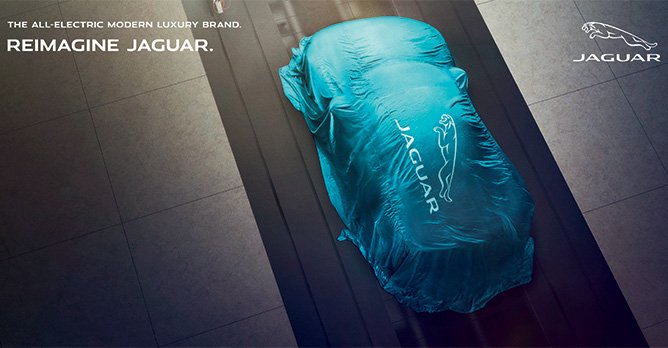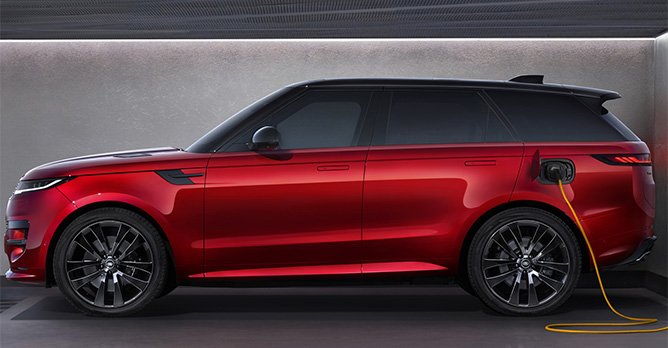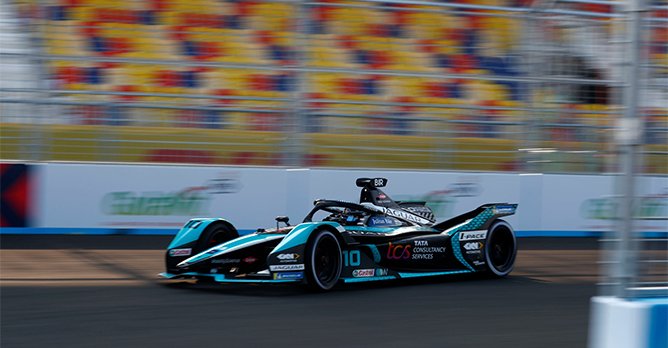Britain's biggest carmaker is pursuing an 'electric-first business' - with Jaguar going all-electric by 2025. We try to figure out what that entails
12 Jul 2022|2,974 views
Jaguar Land Rover is firing on all cylinders for the Reimagine strategy it announced last year - well, purely in a figurative sense, that is.
Because under the plan - which struck headlines alongside the lightning bolt shock that the production-ready Jaguar XJ sedan was getting the chop - the British manufacturer is attempting something that most carmakers have already set out to do, but with a far more aggressive timeline: It's going electric. Fast.
One may admittedly not sense this urgency so much when looking just at Land Rover, which should see its first all-electric model debut in 2024, followed by another five all the way up to 2027. In Jaguar's lineup, however, you won't be able to find a single petrol or diesel-powered model come 2025; the brand will be electric-only. That's merely three years from now.
A quick scan of contemporaries in the luxury field will show that the competitor with the closest timeline is Audi, which has laid out an end-2026 target to switch to EV-only production. Mercedes-Benz is further behind in 2030 - but then it's also added that it will hold the combustion engine out for a few markets that have yet to ripen. BMW, well afoot with its electrification strategy, doesn't even have an official concrete deadline for a complete switchover.

 The unveiled strategy will also see Land Rover releasing six all-electric models in the next five years Considering indications that the new all-electric Jaguars should start delivery in 2025, the firm's decision to remain tight-lipped - even as competitors pull out both bespoke and converted EVs out of their hat by the quarter - has only grown more apparent.
The unveiled strategy will also see Land Rover releasing six all-electric models in the next five years Considering indications that the new all-electric Jaguars should start delivery in 2025, the firm's decision to remain tight-lipped - even as competitors pull out both bespoke and converted EVs out of their hat by the quarter - has only grown more apparent.
When we pry for details on the 2025 lineup via an email interview with Martin Limpert, Overseas Director of Jaguar Land Rover, he remains similarly coy ("Unfortunately, we can't share much at this stage about Jaguar's transformation"). Nonetheless, Limpert also stresses that the company has already "defined what 'new' Jaguar will represent" - and that this, according to him, will be "a brand respectful of its past, but not bound by it".
Having to let our minds run wild to visualise what will emerge from a strategy named 'Reimagine' feels both apt and cruel at once. But for now, there are actually a few key pillars that we don't have to continue wondering about.
For one, a confirmed bespoke platform, apparently code-named the Panthera, will be utilised by electrified cars from both Jaguar and Land Rover in the future. Worth noting is that the initial plan was to borrow an existing electric vehicle architecture from other manufacturers, but this was apparently canned in order to serve an unprecedented, inimitable design language for the new Jaguars. As Limpert tells us, "[the cars] will be a copy of nothing".
Serving alongside this is what JLR calls the Modular Longitudinal Architecture. This was supposed to underpin the cancelled XJ, and a variant of it (called the MLA-Flex) now underpins the new Range Rover and Range Rover Sport, allowing for its plug-in hybrid drivetrains. This "modular and simplified architecture strategy", Limpert tells us, "is central to [the firm's] transformation and journey towards becoming an electric-first business".
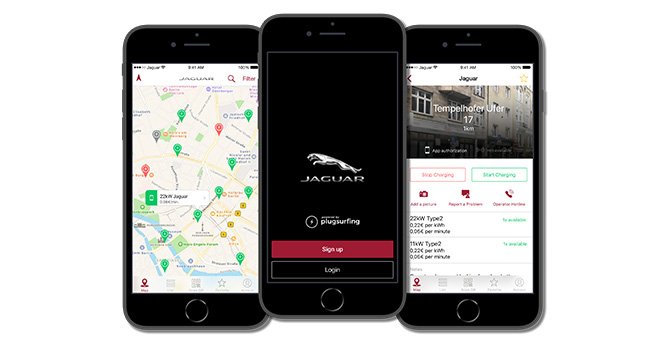
 JLR has been in partnership with Plugsurfing since 2018 to provide charging for its European EV-drivers But beyond the drivetrains themselves, the other, often-overlooked part of the Reimagine-era is JLR's claim that its cars will embody 'Modern Luxury'. To this end, the manufacturer is keeping the pedal steady on its collaborations with other heavyweights in proximate industries.
JLR has been in partnership with Plugsurfing since 2018 to provide charging for its European EV-drivers But beyond the drivetrains themselves, the other, often-overlooked part of the Reimagine-era is JLR's claim that its cars will embody 'Modern Luxury'. To this end, the manufacturer is keeping the pedal steady on its collaborations with other heavyweights in proximate industries.
Limpert reminds us that service provider Plugsurfing has been responsible for powering the Jaguar and Land Rover Charging apps in Europe (although not yet in Singapore). The apps allow drivers to instantly filter out charging points with power ratings that fit the specific battery architectures of their cars, then pay on-the-go. Subscription plans have also already been in place for a while.
JLR has also aggressively pursued a string of partnerships with tech partners in recent months. In April, it announced an Open Innovation strategy, under which an innovation hub will be jointly opened in the U.K. with corporate innovation platform and investor, Plug and Play. Earlier in June, it rolled out over-the-air updates for its cars to offer the tech from advanced geocoding start-up, what3words, to enhance the capabilities of their satnav.

 Jensen Huang (left), President and CEO of NVIDIA, and Thierry Bollore (right), CEO of Jaguar Land Rover But the crowning collaboration, perhaps, is a multi-year strategic partnership with tech giant NVIDIA that will see future JLR cars built on the latter's software-defined platform. In the move towards autonomous vehicles, Limpert says that "next-generation automated driving systems plus AI-enabled services and experiences" will arise from the partnership.
Jensen Huang (left), President and CEO of NVIDIA, and Thierry Bollore (right), CEO of Jaguar Land Rover But the crowning collaboration, perhaps, is a multi-year strategic partnership with tech giant NVIDIA that will see future JLR cars built on the latter's software-defined platform. In the move towards autonomous vehicles, Limpert says that "next-generation automated driving systems plus AI-enabled services and experiences" will arise from the partnership.
And above all, JLR is taking its role as an automotive conglomerate seriously in the fight against climate change. Concrete goals have already been laid out so that emissions are reduced on all possible fronts - what Limpert calls a "canvas of true sustainability", which involves the manufacturer's entire value chain.
JLR has already committed a 46 percent reduction of greenhouse gas emissions across all its operations by 2030. For the use phase of its vehicles - starting from the point that a Jaguar or Land Rover first hits the road, and ending theoretically when it finally runs its last mile - the targeted reduction is 60 percent.
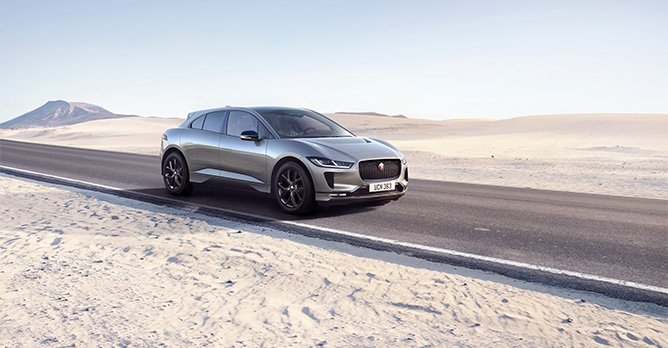
 Although continuing into the new pure-electric era, the I-PACE will be distinct from Jaguar's new EVs These aren't fancy targets pulled out of the air too, but realistic challenges for the company which have been approved by the Science Based Targets initiative (SBTi), which aims to drive corporate climate action and is backed by the WWF.
Although continuing into the new pure-electric era, the I-PACE will be distinct from Jaguar's new EVs These aren't fancy targets pulled out of the air too, but realistic challenges for the company which have been approved by the Science Based Targets initiative (SBTi), which aims to drive corporate climate action and is backed by the WWF.
On multiple fronts, however, the same difficult questions about electrification naturally linger.
Limpert is reluctant to go into the specifics on the future of JLR's Special Vehicle Operations (SVO) division when we try prodding. (Embedded within - perhaps more importantly to the V8 diehards among us - is the unanswered question too of what will happen to well-loved machines like the F-PACE SVR and XE SV Project 8.) But he also reassures us that as part of Jaguar's transformation, "a key objective is to establish new benchmarks in the luxury sector for client relationships".
Likewise, Limpert is also willing to acknowledge that some markets will be more receptive than others to EVs, and that the company's strategies "will need to be carefully calibrated… to ensure the necessary infrastructure and policies are in place to support the shift". To this end, he also admits that "there will be a need for different forms of electrified vehicles including standard hybrids".
Nonetheless, he points out that Singapore presents itself as a bright spot "because of the very nature of the government", which has laid out plans to move towards cleaner vehicles under the Singapore Green Plan 2030.
Singapore also serves as the regional office for the "important region" of Asia Pacific, and Limpert has faith that the steps taken locally to encourage EV-adoption harmonise well with what the company has laid out.
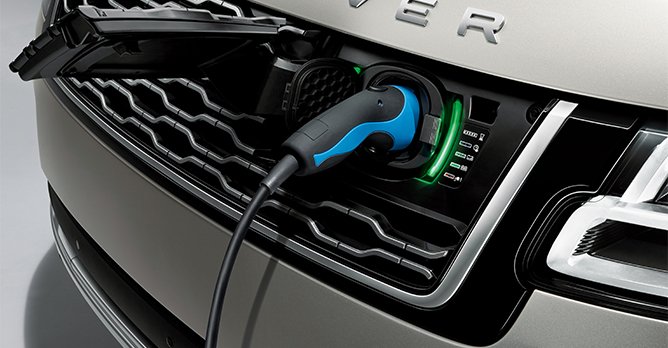
 Limpert believes Singapore is in a good place to benefit from the Reimagine plan, in light of the local government's strong support for EVs Understandably, the picture on the Reimagine era of JLR may still seem quite hazy at this juncture. But what we've seen thus far is indicative of the inventiveness that the U.K.'s largest manufacturer is keen on injecting into its future. Based on what's emerged over the past half year at least, the dots are also slowly getting connected together.
Limpert believes Singapore is in a good place to benefit from the Reimagine plan, in light of the local government's strong support for EVs Understandably, the picture on the Reimagine era of JLR may still seem quite hazy at this juncture. But what we've seen thus far is indicative of the inventiveness that the U.K.'s largest manufacturer is keen on injecting into its future. Based on what's emerged over the past half year at least, the dots are also slowly getting connected together.
We may not concretely know the DNA of the next genus of JLR cars yet. But we can at least rest assured that we - in Singapore - will be well-equipped to receive and enjoy them come 2025.
Because under the plan - which struck headlines alongside the lightning bolt shock that the production-ready Jaguar XJ sedan was getting the chop - the British manufacturer is attempting something that most carmakers have already set out to do, but with a far more aggressive timeline: It's going electric. Fast.
One may admittedly not sense this urgency so much when looking just at Land Rover, which should see its first all-electric model debut in 2024, followed by another five all the way up to 2027. In Jaguar's lineup, however, you won't be able to find a single petrol or diesel-powered model come 2025; the brand will be electric-only. That's merely three years from now.
A quick scan of contemporaries in the luxury field will show that the competitor with the closest timeline is Audi, which has laid out an end-2026 target to switch to EV-only production. Mercedes-Benz is further behind in 2030 - but then it's also added that it will hold the combustion engine out for a few markets that have yet to ripen. BMW, well afoot with its electrification strategy, doesn't even have an official concrete deadline for a complete switchover.

When we pry for details on the 2025 lineup via an email interview with Martin Limpert, Overseas Director of Jaguar Land Rover, he remains similarly coy ("Unfortunately, we can't share much at this stage about Jaguar's transformation"). Nonetheless, Limpert also stresses that the company has already "defined what 'new' Jaguar will represent" - and that this, according to him, will be "a brand respectful of its past, but not bound by it".
Having to let our minds run wild to visualise what will emerge from a strategy named 'Reimagine' feels both apt and cruel at once. But for now, there are actually a few key pillars that we don't have to continue wondering about.
For one, a confirmed bespoke platform, apparently code-named the Panthera, will be utilised by electrified cars from both Jaguar and Land Rover in the future. Worth noting is that the initial plan was to borrow an existing electric vehicle architecture from other manufacturers, but this was apparently canned in order to serve an unprecedented, inimitable design language for the new Jaguars. As Limpert tells us, "[the cars] will be a copy of nothing".
Serving alongside this is what JLR calls the Modular Longitudinal Architecture. This was supposed to underpin the cancelled XJ, and a variant of it (called the MLA-Flex) now underpins the new Range Rover and Range Rover Sport, allowing for its plug-in hybrid drivetrains. This "modular and simplified architecture strategy", Limpert tells us, "is central to [the firm's] transformation and journey towards becoming an electric-first business".

Limpert reminds us that service provider Plugsurfing has been responsible for powering the Jaguar and Land Rover Charging apps in Europe (although not yet in Singapore). The apps allow drivers to instantly filter out charging points with power ratings that fit the specific battery architectures of their cars, then pay on-the-go. Subscription plans have also already been in place for a while.
JLR has also aggressively pursued a string of partnerships with tech partners in recent months. In April, it announced an Open Innovation strategy, under which an innovation hub will be jointly opened in the U.K. with corporate innovation platform and investor, Plug and Play. Earlier in June, it rolled out over-the-air updates for its cars to offer the tech from advanced geocoding start-up, what3words, to enhance the capabilities of their satnav.

And above all, JLR is taking its role as an automotive conglomerate seriously in the fight against climate change. Concrete goals have already been laid out so that emissions are reduced on all possible fronts - what Limpert calls a "canvas of true sustainability", which involves the manufacturer's entire value chain.
JLR has already committed a 46 percent reduction of greenhouse gas emissions across all its operations by 2030. For the use phase of its vehicles - starting from the point that a Jaguar or Land Rover first hits the road, and ending theoretically when it finally runs its last mile - the targeted reduction is 60 percent.

On multiple fronts, however, the same difficult questions about electrification naturally linger.
Limpert is reluctant to go into the specifics on the future of JLR's Special Vehicle Operations (SVO) division when we try prodding. (Embedded within - perhaps more importantly to the V8 diehards among us - is the unanswered question too of what will happen to well-loved machines like the F-PACE SVR and XE SV Project 8.) But he also reassures us that as part of Jaguar's transformation, "a key objective is to establish new benchmarks in the luxury sector for client relationships".
Likewise, Limpert is also willing to acknowledge that some markets will be more receptive than others to EVs, and that the company's strategies "will need to be carefully calibrated… to ensure the necessary infrastructure and policies are in place to support the shift". To this end, he also admits that "there will be a need for different forms of electrified vehicles including standard hybrids".
Nonetheless, he points out that Singapore presents itself as a bright spot "because of the very nature of the government", which has laid out plans to move towards cleaner vehicles under the Singapore Green Plan 2030.
Singapore also serves as the regional office for the "important region" of Asia Pacific, and Limpert has faith that the steps taken locally to encourage EV-adoption harmonise well with what the company has laid out.

We may not concretely know the DNA of the next genus of JLR cars yet. But we can at least rest assured that we - in Singapore - will be well-equipped to receive and enjoy them come 2025.
Jaguar Land Rover is firing on all cylinders for the Reimagine strategy it announced last year - well, purely in a figurative sense, that is.
Because under the plan - which struck headlines alongside the lightning bolt shock that the production-ready Jaguar XJ sedan was getting the chop - the British manufacturer is attempting something that most carmakers have already set out to do, but with a far more aggressive timeline: It's going electric. Fast.
One may admittedly not sense this urgency so much when looking just at Land Rover, which should see its first all-electric model debut in 2024, followed by another five all the way up to 2027. In Jaguar's lineup, however, you won't be able to find a single petrol or diesel-powered model come 2025; the brand will be electric-only. That's merely three years from now.
A quick scan of contemporaries in the luxury field will show that the competitor with the closest timeline is Audi, which has laid out an end-2026 target to switch to EV-only production. Mercedes-Benz is further behind in 2030 - but then it's also added that it will hold the combustion engine out for a few markets that have yet to ripen. BMW, well afoot with its electrification strategy, doesn't even have an official concrete deadline for a complete switchover.

 The unveiled strategy will also see Land Rover releasing six all-electric models in the next five years Considering indications that the new all-electric Jaguars should start delivery in 2025, the firm's decision to remain tight-lipped - even as competitors pull out both bespoke and converted EVs out of their hat by the quarter - has only grown more apparent.
The unveiled strategy will also see Land Rover releasing six all-electric models in the next five years Considering indications that the new all-electric Jaguars should start delivery in 2025, the firm's decision to remain tight-lipped - even as competitors pull out both bespoke and converted EVs out of their hat by the quarter - has only grown more apparent.
When we pry for details on the 2025 lineup via an email interview with Martin Limpert, Overseas Director of Jaguar Land Rover, he remains similarly coy ("Unfortunately, we can't share much at this stage about Jaguar's transformation"). Nonetheless, Limpert also stresses that the company has already "defined what 'new' Jaguar will represent" - and that this, according to him, will be "a brand respectful of its past, but not bound by it".
Having to let our minds run wild to visualise what will emerge from a strategy named 'Reimagine' feels both apt and cruel at once. But for now, there are actually a few key pillars that we don't have to continue wondering about.
For one, a confirmed bespoke platform, apparently code-named the Panthera, will be utilised by electrified cars from both Jaguar and Land Rover in the future. Worth noting is that the initial plan was to borrow an existing electric vehicle architecture from other manufacturers, but this was apparently canned in order to serve an unprecedented, inimitable design language for the new Jaguars. As Limpert tells us, "[the cars] will be a copy of nothing".
Serving alongside this is what JLR calls the Modular Longitudinal Architecture. This was supposed to underpin the cancelled XJ, and a variant of it (called the MLA-Flex) now underpins the new Range Rover and Range Rover Sport, allowing for its plug-in hybrid drivetrains. This "modular and simplified architecture strategy", Limpert tells us, "is central to [the firm's] transformation and journey towards becoming an electric-first business".

 JLR has been in partnership with Plugsurfing since 2018 to provide charging for its European EV-drivers But beyond the drivetrains themselves, the other, often-overlooked part of the Reimagine-era is JLR's claim that its cars will embody 'Modern Luxury'. To this end, the manufacturer is keeping the pedal steady on its collaborations with other heavyweights in proximate industries.
JLR has been in partnership with Plugsurfing since 2018 to provide charging for its European EV-drivers But beyond the drivetrains themselves, the other, often-overlooked part of the Reimagine-era is JLR's claim that its cars will embody 'Modern Luxury'. To this end, the manufacturer is keeping the pedal steady on its collaborations with other heavyweights in proximate industries.
Limpert reminds us that service provider Plugsurfing has been responsible for powering the Jaguar and Land Rover Charging apps in Europe (although not yet in Singapore). The apps allow drivers to instantly filter out charging points with power ratings that fit the specific battery architectures of their cars, then pay on-the-go. Subscription plans have also already been in place for a while.
JLR has also aggressively pursued a string of partnerships with tech partners in recent months. In April, it announced an Open Innovation strategy, under which an innovation hub will be jointly opened in the U.K. with corporate innovation platform and investor, Plug and Play. Earlier in June, it rolled out over-the-air updates for its cars to offer the tech from advanced geocoding start-up, what3words, to enhance the capabilities of their satnav.

 Jensen Huang (left), President and CEO of NVIDIA, and Thierry Bollore (right), CEO of Jaguar Land Rover But the crowning collaboration, perhaps, is a multi-year strategic partnership with tech giant NVIDIA that will see future JLR cars built on the latter's software-defined platform. In the move towards autonomous vehicles, Limpert says that "next-generation automated driving systems plus AI-enabled services and experiences" will arise from the partnership.
Jensen Huang (left), President and CEO of NVIDIA, and Thierry Bollore (right), CEO of Jaguar Land Rover But the crowning collaboration, perhaps, is a multi-year strategic partnership with tech giant NVIDIA that will see future JLR cars built on the latter's software-defined platform. In the move towards autonomous vehicles, Limpert says that "next-generation automated driving systems plus AI-enabled services and experiences" will arise from the partnership.
And above all, JLR is taking its role as an automotive conglomerate seriously in the fight against climate change. Concrete goals have already been laid out so that emissions are reduced on all possible fronts - what Limpert calls a "canvas of true sustainability", which involves the manufacturer's entire value chain.
JLR has already committed a 46 percent reduction of greenhouse gas emissions across all its operations by 2030. For the use phase of its vehicles - starting from the point that a Jaguar or Land Rover first hits the road, and ending theoretically when it finally runs its last mile - the targeted reduction is 60 percent.

 Although continuing into the new pure-electric era, the I-PACE will be distinct from Jaguar's new EVs These aren't fancy targets pulled out of the air too, but realistic challenges for the company which have been approved by the Science Based Targets initiative (SBTi), which aims to drive corporate climate action and is backed by the WWF.
Although continuing into the new pure-electric era, the I-PACE will be distinct from Jaguar's new EVs These aren't fancy targets pulled out of the air too, but realistic challenges for the company which have been approved by the Science Based Targets initiative (SBTi), which aims to drive corporate climate action and is backed by the WWF.
On multiple fronts, however, the same difficult questions about electrification naturally linger.
Limpert is reluctant to go into the specifics on the future of JLR's Special Vehicle Operations (SVO) division when we try prodding. (Embedded within - perhaps more importantly to the V8 diehards among us - is the unanswered question too of what will happen to well-loved machines like the F-PACE SVR and XE SV Project 8.) But he also reassures us that as part of Jaguar's transformation, "a key objective is to establish new benchmarks in the luxury sector for client relationships".
Likewise, Limpert is also willing to acknowledge that some markets will be more receptive than others to EVs, and that the company's strategies "will need to be carefully calibrated… to ensure the necessary infrastructure and policies are in place to support the shift". To this end, he also admits that "there will be a need for different forms of electrified vehicles including standard hybrids".
Nonetheless, he points out that Singapore presents itself as a bright spot "because of the very nature of the government", which has laid out plans to move towards cleaner vehicles under the Singapore Green Plan 2030.
Singapore also serves as the regional office for the "important region" of Asia Pacific, and Limpert has faith that the steps taken locally to encourage EV-adoption harmonise well with what the company has laid out.

 Limpert believes Singapore is in a good place to benefit from the Reimagine plan, in light of the local government's strong support for EVs Understandably, the picture on the Reimagine era of JLR may still seem quite hazy at this juncture. But what we've seen thus far is indicative of the inventiveness that the U.K.'s largest manufacturer is keen on injecting into its future. Based on what's emerged over the past half year at least, the dots are also slowly getting connected together.
Limpert believes Singapore is in a good place to benefit from the Reimagine plan, in light of the local government's strong support for EVs Understandably, the picture on the Reimagine era of JLR may still seem quite hazy at this juncture. But what we've seen thus far is indicative of the inventiveness that the U.K.'s largest manufacturer is keen on injecting into its future. Based on what's emerged over the past half year at least, the dots are also slowly getting connected together.
We may not concretely know the DNA of the next genus of JLR cars yet. But we can at least rest assured that we - in Singapore - will be well-equipped to receive and enjoy them come 2025.
Because under the plan - which struck headlines alongside the lightning bolt shock that the production-ready Jaguar XJ sedan was getting the chop - the British manufacturer is attempting something that most carmakers have already set out to do, but with a far more aggressive timeline: It's going electric. Fast.
One may admittedly not sense this urgency so much when looking just at Land Rover, which should see its first all-electric model debut in 2024, followed by another five all the way up to 2027. In Jaguar's lineup, however, you won't be able to find a single petrol or diesel-powered model come 2025; the brand will be electric-only. That's merely three years from now.
A quick scan of contemporaries in the luxury field will show that the competitor with the closest timeline is Audi, which has laid out an end-2026 target to switch to EV-only production. Mercedes-Benz is further behind in 2030 - but then it's also added that it will hold the combustion engine out for a few markets that have yet to ripen. BMW, well afoot with its electrification strategy, doesn't even have an official concrete deadline for a complete switchover.

When we pry for details on the 2025 lineup via an email interview with Martin Limpert, Overseas Director of Jaguar Land Rover, he remains similarly coy ("Unfortunately, we can't share much at this stage about Jaguar's transformation"). Nonetheless, Limpert also stresses that the company has already "defined what 'new' Jaguar will represent" - and that this, according to him, will be "a brand respectful of its past, but not bound by it".
Having to let our minds run wild to visualise what will emerge from a strategy named 'Reimagine' feels both apt and cruel at once. But for now, there are actually a few key pillars that we don't have to continue wondering about.
For one, a confirmed bespoke platform, apparently code-named the Panthera, will be utilised by electrified cars from both Jaguar and Land Rover in the future. Worth noting is that the initial plan was to borrow an existing electric vehicle architecture from other manufacturers, but this was apparently canned in order to serve an unprecedented, inimitable design language for the new Jaguars. As Limpert tells us, "[the cars] will be a copy of nothing".
Serving alongside this is what JLR calls the Modular Longitudinal Architecture. This was supposed to underpin the cancelled XJ, and a variant of it (called the MLA-Flex) now underpins the new Range Rover and Range Rover Sport, allowing for its plug-in hybrid drivetrains. This "modular and simplified architecture strategy", Limpert tells us, "is central to [the firm's] transformation and journey towards becoming an electric-first business".

Limpert reminds us that service provider Plugsurfing has been responsible for powering the Jaguar and Land Rover Charging apps in Europe (although not yet in Singapore). The apps allow drivers to instantly filter out charging points with power ratings that fit the specific battery architectures of their cars, then pay on-the-go. Subscription plans have also already been in place for a while.
JLR has also aggressively pursued a string of partnerships with tech partners in recent months. In April, it announced an Open Innovation strategy, under which an innovation hub will be jointly opened in the U.K. with corporate innovation platform and investor, Plug and Play. Earlier in June, it rolled out over-the-air updates for its cars to offer the tech from advanced geocoding start-up, what3words, to enhance the capabilities of their satnav.

And above all, JLR is taking its role as an automotive conglomerate seriously in the fight against climate change. Concrete goals have already been laid out so that emissions are reduced on all possible fronts - what Limpert calls a "canvas of true sustainability", which involves the manufacturer's entire value chain.
JLR has already committed a 46 percent reduction of greenhouse gas emissions across all its operations by 2030. For the use phase of its vehicles - starting from the point that a Jaguar or Land Rover first hits the road, and ending theoretically when it finally runs its last mile - the targeted reduction is 60 percent.

On multiple fronts, however, the same difficult questions about electrification naturally linger.
Limpert is reluctant to go into the specifics on the future of JLR's Special Vehicle Operations (SVO) division when we try prodding. (Embedded within - perhaps more importantly to the V8 diehards among us - is the unanswered question too of what will happen to well-loved machines like the F-PACE SVR and XE SV Project 8.) But he also reassures us that as part of Jaguar's transformation, "a key objective is to establish new benchmarks in the luxury sector for client relationships".
Likewise, Limpert is also willing to acknowledge that some markets will be more receptive than others to EVs, and that the company's strategies "will need to be carefully calibrated… to ensure the necessary infrastructure and policies are in place to support the shift". To this end, he also admits that "there will be a need for different forms of electrified vehicles including standard hybrids".
Nonetheless, he points out that Singapore presents itself as a bright spot "because of the very nature of the government", which has laid out plans to move towards cleaner vehicles under the Singapore Green Plan 2030.
Singapore also serves as the regional office for the "important region" of Asia Pacific, and Limpert has faith that the steps taken locally to encourage EV-adoption harmonise well with what the company has laid out.

We may not concretely know the DNA of the next genus of JLR cars yet. But we can at least rest assured that we - in Singapore - will be well-equipped to receive and enjoy them come 2025.
Thank You For Your Subscription.










